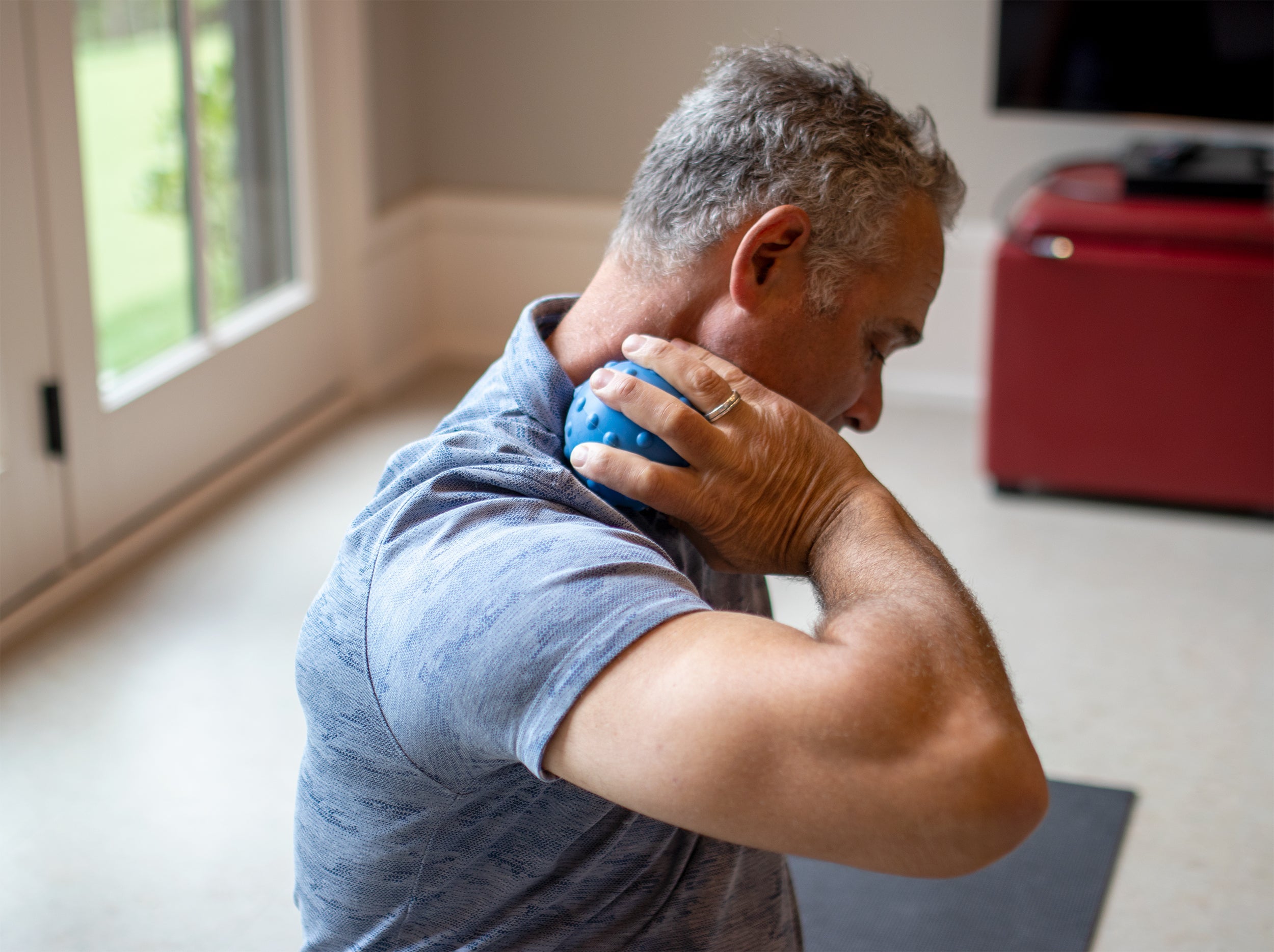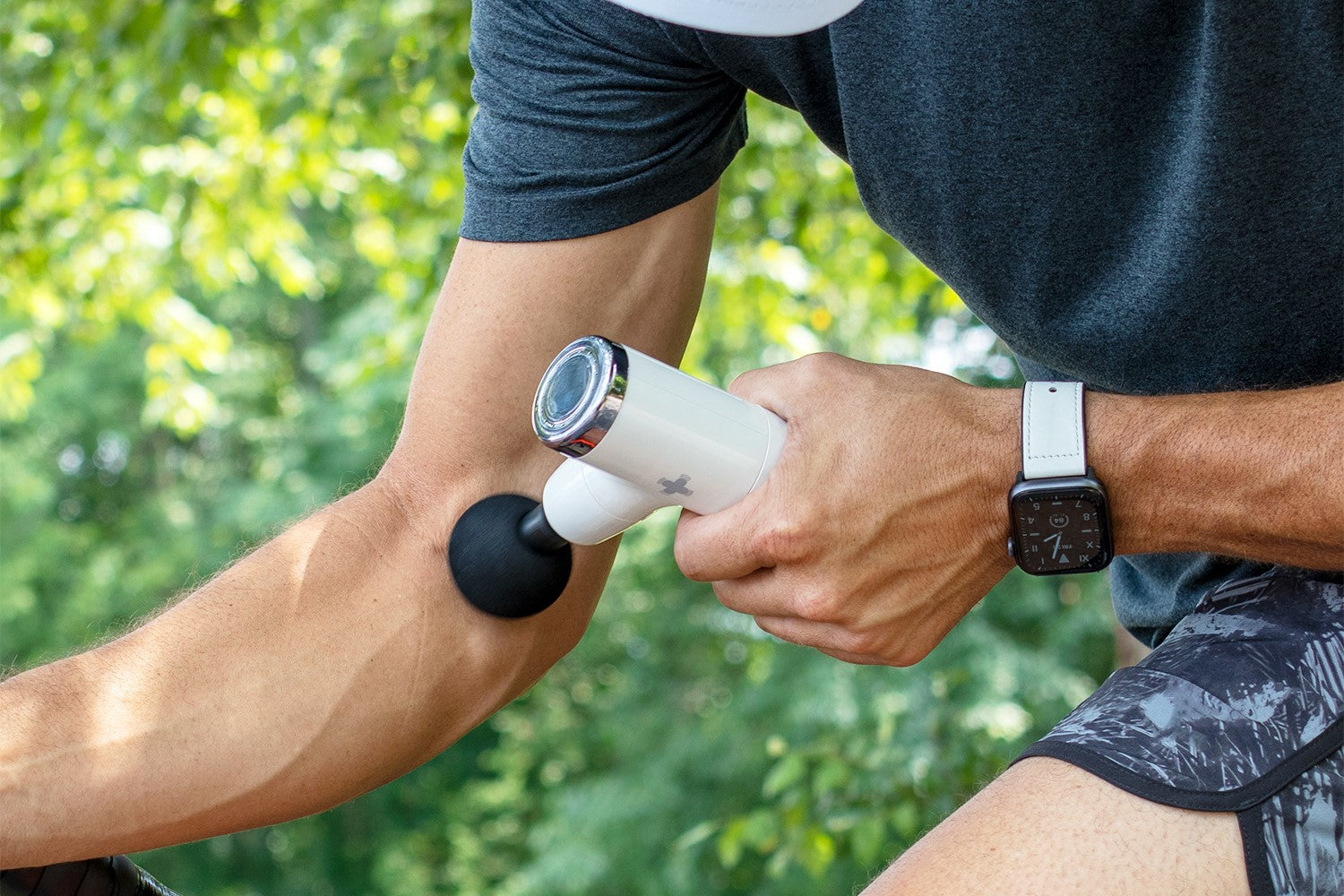Have you been dealing with muscle pain in the upper side of your ribs?
Perhaps you’ve been going hard on the tennis court lately. Or, maybe you’re a weightlifter who’s noticed pain there for a while now. In any case, this unusual ache may be serratus anterior pain — stemming from a small, fan-shaped muscle that wraps around your rib cage.
So, what triggers pain in this region, and how can you alleviate it? Below, learn about some common causes of serratus anterior pain, along with six remedies to try for relief.
Understanding the Serratus Anterior Muscle
The serratus anterior is a thin, serrated-looking muscle that helps to move and stabilize your shoulder blades (scapulas). It’s located on the side of your rib cage, just between your latissimus dorsi and pectoralis major muscles.
Along with shoulder blade stability, this powerful muscle helps with shoulder mobility and rotation. Some even refer to it as the “boxer’s muscle” — because it fires up when you throw your shoulder blade forward (like you would in a punch.)
It plays a key role in many movements, but it can sometimes be small and difficult to see. However, some athletes — especially bodybuilders — have larger and more defined serratus anterior muscles. When visible, these muscles create a rippled texture over the upper side of the rib cage.
What Does Serratus Anterior Pain Feel Like?
If you’ve got an achy or tight serratus anterior muscle, it may feel like:
- Pain in the upper side of the ribs, in front of the latissimus dorsi
- Soreness when breathing deeply (since your rib cage expands when you inhale)
- Muscle pain near the chest or armpit
Beyond pain in the muscle itself, a weak or injured serratus anterior can affect other parts of your body. For example, it can impact the stability of shoulders, shoulder blades, and your posture as a whole.
Who Gets Serratus Anterior Pain?
While the serratus anterior muscles can help you throw a punch, pain in this region doesn’t only affect boxers. Beyond those who practice martial arts, here are some others who may deal with pain in this muscle:
- Swimmers
- Tennis, badminton, and other racket sports players
- Sprinters and runners
- Football players
- Weightlifters
- Anyone who works in ways that require repetitive arm motions
Most Common Causes of Serratus Anterior Pain
Serratus anterior pain can come up for all sorts of reasons. The good news is that it’s typically not serious, and often boils down to simple muscle soreness.
With that in mind, here are a few of the most common culprits behind pain in this fan-shaped muscle:
Overuse, Strain, and Tension
As mentioned above, the serratus anterior is key to shoulder blade stability, shoulder rotation, and overhead motions. And for those with active lifestyles, overuse is a common cause of pain in this thin muscle.
For example, swinging a racket for hours at a time can put significant stress on the serratus anterior. And too much of this can lead to an achy strain that lasts a few days or weeks.
Fortunately, overuse-related pain usually resolves on its own with time, rest, and a little TLC.
Delayed Onset Muscle Soreness (DOMS)
Have you recently started a new fitness routine? If so, delayed onset muscle soreness (DOMS) may be the reason for your serratus anterior pain.
Planks, overhead movements, and other shoulder-activating exercises can all target these muscles. The good news is that post-workout soreness is normal (especially if you haven’t worked out in a while), and it usually heals up within a few days.
Serratus Anterior Myofascial Pain Syndrome
Long-term serratus anterior pain can be linked to serratus anterior myofascial pain syndrome (SAMPS). SAMPS is a rare condition that’s typically only diagnosed once other reasons for pain have been ruled out.
As a whole, myofascial pain syndromes can resemble everyday muscle pain. The main difference is that they are more severe and don’t let up over time. They may also come with deep aches and painful trigger points near the affected area.
Other Injuries or Conditions
Aside from SAMPS, other conditions can also lead to serratus anterior pain. This is why it’s always essential to check with your doctor if your pain feels unusual or different from a normal muscle ache.
The other potential causes include but are not limited to:
- A rib injury or broken rib
- Pleurisy
- Trauma
- Nerve conditions
- Arthritis affecting the spine
Remedies for Serratus Anterior Pain
Whether you’re dealing with DOMS or general muscle tightness, the good news is that certain remedies can bring you relief.
Here are some of the best recovery methods to try:
1. Cut Out Any Painful Activities
As a first step, it can help to cut back on any painful activities that may be aggravating the muscle. For example, if certain exercises worsen your pain, consider switching up your workout routine to focus on other muscle groups instead.
2. Try the RICE Method
When it comes to muscle strains and minor injuries, the RICE method is one of the most common action plans that doctors recommend. This recovery approach involves:
- Rest: Take some time to allow your body to heal the injury.
- Ice. Use cold packs to keep inflammation and pain at bay.
- Compression: If practical, compress the area to keep swelling down.
- Elevate: Elevate the body part above the heart to reduce swelling (not necessarily relevant to serratus anterior pain.)
When you have a muscle injury, your doctor may also recommend pairing the RICE method with over-the-counter pain medications — such as ibuprofen or naproxen.
3. Give Your Serratus Anterior Muscles a Gentle Stretch
If your serratus anterior feels tense due to overuse or working out, some gentle stretching can help boost healthy blood flow and lengthen the muscle.
To get started, here are three helpful stretches that can make a big difference in your routine:
Tip: Be slow and mindful as you do these stretches. Focus on decreasing the muscle tension, and don’t worry too much about flexibility — instead, just aim for a gentle, comfortable stretch.
Always talk to your doctor before starting a new movement routine, and be sure to stop if anything feels numb, tingly, or painful.
Behind-the-Head Stretch
This exercise stretches the serratus anterior by pulling your shoulder blades back and closer to the spine. On top of that, it can also target and lengthen your upper arm muscles.
Here are the steps:
- Start by sitting on a comfortable chair or flat surface.
- Take a deep breath, sit tall, and check to see that your spine is straight.
- Then, reach up and clasp your hands behind your head.
- Mindfully pull the bottom of the shoulder blades back towards each other until you feel a gentle stretch in your sides.
- Hold for 10 to 30 seconds.
Simple Chair Stretch
This basic chair stretch is an easy way to get a deep stretch in the serratus anterior muscle. To start, all you’ll need is a chair with a low enough back so that you can drape your arm over the edge. Then:
- Have a seat facing sideways, so your affected side is next to the back of the chair.
- Drape your arm over the chair with your elbow bent. Then, grab the edge of the backrest to keep your arm in place.
- Slowly turn your head, neck, and body away from the chair. As you do, you should feel a gentle stretch in the serratus anterior muscle.
- Hold for 10 to 30 seconds. (Alternatively, you can make this a dynamic stretch by doing 1 to 2 sets of 10 short reps.)
Lying-Down Serratus Anterior Stretch
This exercise offers an easy way to target and lengthen a tense, achy serratus anterior. To try it, you’ll need a comfortable, even surface to lie on — such as a soft rug or yoga mat. (And since you’ll be on the ground, be sure to grab a pillow to help support your neck!)
Once you’ve got all your supplies, here’s how to do the stretch:
- Lie down so that the side you’re not stretching is on the ground.
- Bend your knees and pull them forward. This will help keep your spine in a neutral position.
- Using the arm you’re planning to stretch, slowly bring your hand up to your hip. (Tip: Avoid hunching up your shoulder during this step.)
- With your hand still in position, lower your elbow behind your body until you feel a stretch in the side.
- Hold for 20 to 30 seconds.
For a visual guide to make this exercise easier, this tutorial can help.
4. Hands-On Self-Massage

When you’ve got an achy muscle, self-massage is one of the most relaxing remedies to use. And even though the serratus anterior can sometimes be tough to see, a gentle massage where you feel the most tension can help soothe the muscle — and those surrounding it.
Here are the steps:
- Use your hand to gently feel around the serratus anterior muscle. You can find it by reaching to the side of your chest, under the armpit, and on the ribs.
- Lightly massage this area in large circular motions for 30 seconds.
- Continue to massage the surrounding areas — including the lats and chest muscles — for 30 seconds more.
- To reach more deeply into the muscles, you can raise your arm up above your head while you massage.
- If you come across a trigger point, pause over the area and hold the pressure for a few extra seconds.
- Repeat these steps for 3 to 5 minutes, or as long as it feels good to you.
5. Foam Rolling the Serratus Anterior Region
Have you noticed deep knots and tension near your serratus anterior muscles? If so, a self-myofascial release session may be exactly what you need to break up the tightness and discomfort.
If you’ve got a foam roller on hand, here’s one exercise to try:
- Start by lying on your side with your foam roller underneath your armpit, at about a 45-degree angle to your body. In this position, the roller should point diagonally upward in front of you (and downward behind you.)
- Slowly rotate back and forth across the roller to find tender spots. Since this area is so delicate, it’s essential to use light pressure as you roll.
- Pause over any trigger points for 20 seconds or so, using mild pressure to release the tension.
- Continue to roll for 1 to 2 minutes.
6. Try a Massage Ball
When it comes to serratus anterior pain, a massage (or tennis) ball is another soothing tool worth trying. You can use one by following these steps:
- Lightly roll your massage ball across your serratus anterior to warm it up.
- Then, bend your arm, point your elbow in the air, and place the ball between your serratus anterior and a wall.
- Use delicate pressure to roll the ball around the muscle in any way that feels comfortable to you. (Just like other massage methods, this should feel soothing, relaxing, and not painful. If it causes pain or irritates the muscle, reduce the pressure or try again another day.)
- Roll for a total of 1 to 2 minutes.
How to Strengthen the Serratus Anterior
After your serratus anterior pain heals, strengthening and activating these muscles can help you stay healthy and pain-free in the future. Plus, strong serratus anteriors can support your shoulder blades, posture, and back for the long haul.
Here are two simple yet powerful exercises to help you get started:
Serratus Wall Slide
The serratus wall slide is a simple, no-equipment-needed option for activating the serratus region. Simply:
- Start by standing about one foot from a wall, with your posture straight and tall.
- Raise your arms out in front of you at about shoulder-height. Keep your elbows bent at 90 degrees with your forearms pointing up against the wall.
- Keeping your posture neutral, slowly glide your arms up the wall.
- Lower your arms back to the starting position, and repeat for 2 to 3 sets of 10 to 15 reps.
Scapular Push-Ups
Scapular push-ups offer a powerful way to engage your shoulder blades and serratus anterior muscles.
Give them a try by following these steps:
- Get onto all fours with your arms straight, palms flat on the ground, and knees in line with your hips. Check that your head’s in a neutral position and aligned with your spine.
- With your elbows still straight, squeeze your shoulder blades together and slightly lower your chest.
- Then, push the ground away to bring your shoulder blades forward.
- For an extra challenge, you can straighten your legs, brace your core, and try this exercise from the high plank position.
- Repeat for 10 to 12 reps.
Precautions & When to See Your Doctor
Minor serratus anterior pain normally isn’t anything to worry about, and often heals up on its own. However, in rare cases, it can be a symptom of a more serious issue. So, what precautions should you take, and when should you see your healthcare team?
If you’re sure that it’s only minor muscle pain, listen to your body while trying different remedies. Avoid anything that aggravates your pain, and only stick to the recovery methods that bring you relief.
If you have other symptoms — like dizziness, breathing problems, a stiff neck, fever, or any other unusual sensations — be sure to get in touch with your doctor. Additionally, give them a call if your pain worsens, disrupts your everyday life, or doesn’t seem to get better in a few days.
The Takeaway
If you have muscle pain near your upper ribs or shoulder blade, your serratus anterior may be to blame. This thin, fan-shaped muscle plays a vital role in shoulder blade stability, and can end up sore for a few different reasons.
The good news? The causes of serratus anterior pain are usually simple, everyday things — like overuse, knots, or a new workout routine. And when it’s something minor like this, soothing home remedies can often do the trick.
Rest, stretching, foam rolling, and massage are all great options to melt away your muscle aches. But if your pain persists or you have any doubts, be sure to check with your healthcare team to find the right treatment plan for you.
Get Advanced Massage at Home
Ready to reap the benefits of therapeutic massage in the comfort of your home? The tools from MedMassager can help.
Check out the full selection today, or learn more about their many restorative uses here.



